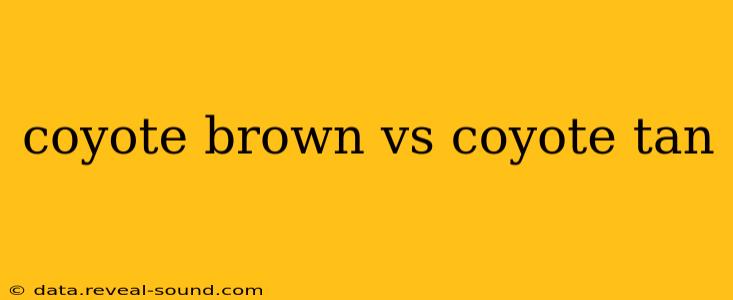Choosing the right camouflage can be crucial, especially in environments like deserts and arid regions. Two colors frequently used in such contexts are Coyote Brown and Coyote Tan. While they might seem similar at first glance, understanding their nuances can significantly impact your performance, whether you're a serious outdoorsman, a military professional, or simply an enthusiast of tactical gear. This article delves into the key differences between Coyote Brown and Coyote Tan, helping you make an informed decision based on your specific needs.
What is Coyote Brown?
Coyote Brown is a relatively dark, earthy tone. It's often described as a muted brown, incorporating hints of gray and green, mimicking the subtle shades found in dry, rocky terrains. Its darker hue makes it effective in providing concealment in areas with shadows and varied vegetation. Think rocky outcrops, scrublands, and dusty plains. The color is frequently used in military and tactical apparel, as well as in hunting and outdoor gear.
What is Coyote Tan?
Coyote Tan, in contrast, is a lighter, more sandy shade of brown. It leans towards a lighter, more bleached-out appearance, better suited to areas with lighter-colored sand, rocks, and sparse vegetation. Think open deserts, beaches, and sandy plains. While still offering camouflage, it's less effective in areas with significant shading or darker background elements.
Coyote Brown vs. Coyote Tan: Key Differences
The core difference boils down to shade and saturation. Coyote Brown is darker and more saturated, while Coyote Tan is lighter and less saturated. This difference is crucial because it directly impacts their effectiveness in various environments.
Shade:
- Coyote Brown: Darker, muted brown with gray and green undertones.
- Coyote Tan: Lighter, sandy brown with less saturation.
Saturation:
- Coyote Brown: More saturated, meaning the color is more intense and less washed-out.
- Coyote Tan: Less saturated, appearing more muted and faded.
Environmental Suitability:
- Coyote Brown: Best suited for areas with varied terrain, including rocky outcrops, scrublands, and areas with significant shadow.
- Coyote Tan: Best suited for open, sandy deserts, beaches, and lightly vegetated areas.
Which Color is Right for Me?
The best choice depends entirely on the environment you'll be using the gear in. Consider the dominant colors of the terrain:
- Predominantly dark or shadowed areas: Coyote Brown offers better concealment.
- Open, sandy areas: Coyote Tan is a more appropriate choice.
Remember, camouflage effectiveness is also influenced by other factors like pattern and texture. A pattern incorporating both colors could offer superior all-around concealment in diverse desert environments.
What are the Differences in Material and Durability?
The color itself doesn't dictate material or durability. Both Coyote Brown and Coyote Tan items can be manufactured using various materials, including nylon, cotton, polyester, or blends thereof. Durability will depend on the specific material, construction, and manufacturer. Check product specifications for details on material composition and durability ratings.
Are Coyote Brown and Coyote Tan Used in Military Applications?
Yes, both colors are used in military applications, but the choice often depends on the specific operational environment. Units deploying to regions with darker, rockier terrains might favor Coyote Brown, while those operating in open sandy deserts might opt for Coyote Tan.
Where Can I Find Gear in Coyote Brown and Coyote Tan?
Many outdoor retailers and tactical gear suppliers offer a wide selection of clothing and equipment in both colors. You can usually find options online or in brick-and-mortar stores specializing in outdoor gear, tactical supplies, or military surplus.
By understanding the subtle yet significant differences between Coyote Brown and Coyote Tan, you can select camouflage that best meets your needs, ensuring optimal performance in your chosen environment. Remember that your choice should always be informed by the specific conditions you anticipate encountering.
